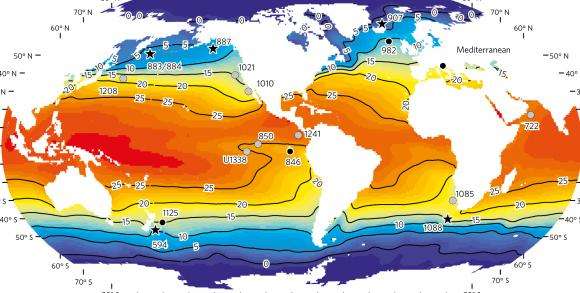Ancient global cooling gave rise to modern ecosystems

Around 7 million years ago, landscapes and ecosystems across the world began changing dramatically. Subtropical regions dried out and the Sahara Desert formed in Africa. Rain forests receded and were replaced by the vast savannas and grasslands that persist today in North and South America, Africa and Asia.
Up to now, these events have generally been explained by separate tectonic events—the uplift of mountain ranges or the alteration of ocean basins—causing discrete and local changes in climate. But in a new study, a team of researchers has shown that these environmental changes coincided with a previously undocumented period of global cooling, which was likely driven by a sharp reduction in atmospheric carbon dioxide.
The research, led by a Brown University geologist and published in Nature Geoscience, is based on a newly developed record of global sea surface temperatures spanning the past 12 million years. The record reveals a distinct period of cooler sea surface temperatures spanning 7 million to 5.4 million years ago, the end of the Miocene epoch. The global climate during the Miocene is known to have been much warmer than the present. During the cool period detected in this study, sea surface temperatures dropped to near modern levels.
"This is the first time the late Miocene has been put in a context of global sea surface temperatures, and we were surprised to see the amount of cooling we found," said Timothy Herbert, professor in the Department of Earth, Environmental and Planetary Sciences at Brown, who led the study. "In light of this temperature change, the paleobiological observations from this period start to make a lot more sense."
The new record of sea surface temperatures was derived from ocean sediment sampled at 17 different sites around the world. The sediment preserves the remains of a plankton species that varies cellular chemistry with temperature. By measuring amounts of those temperature-sensitive molecules, scientists can recreate temperature through time.
The late Miocene cool period was detected at every site sampled, in both hemispheres and in every ocean basin on the planet. The cooling was strongest toward the poles and more moderate toward the equator. That pattern, Herbert says, suggests a global atmospheric cause for the temperature decline. The most likely suspect is carbon dioxide (CO2).
"The hemispheric symmetry and the fact that cooling is much greater at the high latitudes—these are the fingerprints of CO2-related temperature change," Herbert said. "We haven't proven that it was a decline in CO2 because we're not measuring it directly, but we're making a circumstantial case for a reduction in CO2."
The cooler temperatures would likely have played a role in the drying of the subtropics in the late Miocene, the researchers say. "A cooler world—particularly a cooler ocean—would have decreased moisture in the atmosphere," Herbert said. "The hydrological cycle basically slows down with cooling."
And if the cooling was indeed driven by a reduction in atmospheric CO2, it could explain a critical shift in global vegetation that occurred during the late Miocene: the transition from forests to grassland and savanna in the subtropical regions of North and South America, Asia and Africa. These ecosystems are still present today. In Africa, these are the habitats associated with the evolution of our early human ancestors.
Many of the grassy plant species that began thriving during this period are "C4" plants. These species use a slightly different photosynthetic pathway than trees and other plants. The C4 pathway is more efficient in low CO2 environments. "It could be that that if CO2 declined, these C4 species were favored," Herbert said. "So we can associate that shift in vegetation with the same thing that we suspect was driving the late Miocene cooling."
It isn't clear at this point what might have driven a reduction in CO2 during this period, Herbert says. It could be that there were large-scale geological changes occurring at this time that affected the carbon cycle. Herbert's lab is looking into that possibility now.
But what is clear is that there was a significant global shift in global temperatures during the late Miocene.
"The prevailing view was that this wasn't a particularly exciting time in terms of global climate," Herbert said. "It turns out to be more interesting than people thought."
More information: Timothy D. Herbert et al. Late Miocene global cooling and the rise of modern ecosystems, Nature Geoscience (2016). DOI: 10.1038/ngeo2813
Journal information: Nature Geoscience
Provided by Brown University




















